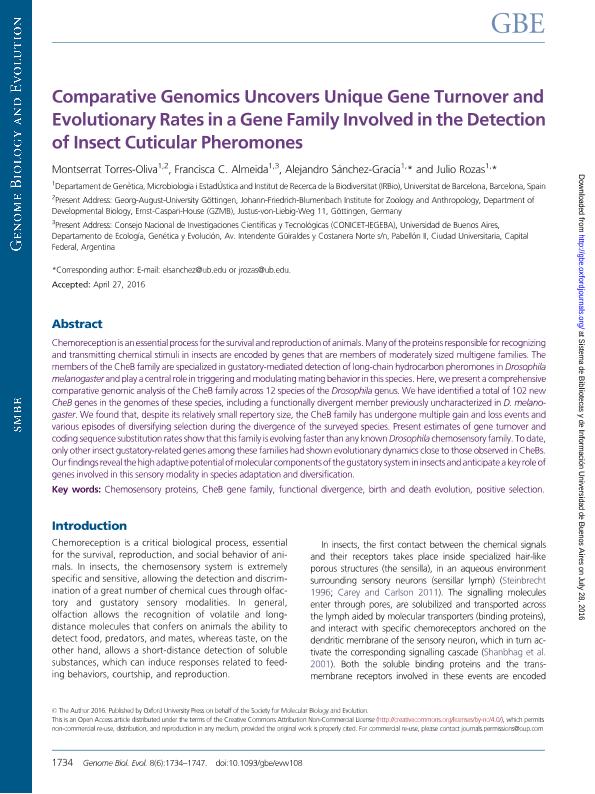Mostrar el registro sencillo del ítem
dc.contributor.author
Torres Oliva, Montserrat
dc.contributor.author
Cunha Almeida, Francisca

dc.contributor.author
Sánchez Gracia, Alejandro
dc.contributor.author
Rozas, Julio
dc.date.available
2018-10-01T19:35:44Z
dc.date.issued
2016-07
dc.identifier.citation
Torres Oliva, Montserrat; Cunha Almeida, Francisca; Sánchez Gracia, Alejandro; Rozas, Julio; Comparative genomics uncovers unique gene turnover and evolutionary rates in a gene family involved in the detection of insect cuticular pheromones; Oxford University Press; Genome Biology and Evolution; 8; 6; 7-2016; 1734-1747
dc.identifier.issn
1759-6653
dc.identifier.uri
http://hdl.handle.net/11336/61434
dc.description.abstract
Chemoreception is an essential process for the survival and reproduction of animals. Many of the proteins responsible for recognizing and transmitting chemical stimuli in insects are encoded by genes that are members of moderately sized multigene families. The members of the CheB family are specialized in gustatory-mediated detection of long-chain hydrocarbon pheromones in Drosophila melanogaster and play a central role in triggering and modulating mating behavior in this species. Here, we present a comprehensive comparative genomic analysis of the CheB family across 12 species of the Drosophila genus. We have identified a total of 102 new CheB genes in the genomes of these species, including a functionally divergent member previously uncharacterized in D. melanogaster. We found that, despite its relatively small repertory size, the CheB family has undergone multiple gain and loss events and various episodes of diversifying selection during the divergence of the surveyed species. Present estimates of gene turnover and coding sequence substitution rates show that this family is evolving faster than any known Drosophila chemosensory family. To date, only other insect gustatory-related genes among these families had shown evolutionary dynamics close to those observed in CheBs. Our findings reveal the high adaptive potential of molecular components of the gustatory system in insects and anticipate a key role of genes involved in this sensory modality in species adaptation and diversification.
dc.format
application/pdf
dc.language.iso
eng
dc.publisher
Oxford University Press

dc.rights
info:eu-repo/semantics/openAccess
dc.rights.uri
https://creativecommons.org/licenses/by-nc-sa/2.5/ar/
dc.subject
Birth
dc.subject
Cheb Gene Family
dc.subject
Chemosensory Proteins
dc.subject
Death Evolution
dc.subject
Functional Divergence
dc.subject
Positive Selection
dc.subject.classification
Otras Ciencias Biológicas

dc.subject.classification
Ciencias Biológicas

dc.subject.classification
CIENCIAS NATURALES Y EXACTAS

dc.title
Comparative genomics uncovers unique gene turnover and evolutionary rates in a gene family involved in the detection of insect cuticular pheromones
dc.type
info:eu-repo/semantics/article
dc.type
info:ar-repo/semantics/artículo
dc.type
info:eu-repo/semantics/publishedVersion
dc.date.updated
2018-10-01T16:09:51Z
dc.journal.volume
8
dc.journal.number
6
dc.journal.pagination
1734-1747
dc.journal.pais
Reino Unido

dc.journal.ciudad
Oxford
dc.description.fil
Fil: Torres Oliva, Montserrat. Universidad de Barcelona; España. Johann Friedrich Blumenbach Institute for Zoology and Anthropology; Alemania
dc.description.fil
Fil: Cunha Almeida, Francisca. Universidad de Barcelona; España. Consejo Nacional de Investigaciones Científicas y Técnicas. Oficina de Coordinación Administrativa Ciudad Universitaria. Instituto de Ecología, Genética y Evolución de Buenos Aires. Universidad de Buenos Aires. Facultad de Ciencias Exactas y Naturales. Instituto de Ecología, Genética y Evolución de Buenos Aires; Argentina
dc.description.fil
Fil: Sánchez Gracia, Alejandro. Universidad de Barcelona; España
dc.description.fil
Fil: Rozas, Julio. Universidad de Barcelona; España
dc.journal.title
Genome Biology and Evolution
dc.relation.alternativeid
info:eu-repo/semantics/altIdentifier/doi/http://dx.doi.org/10.1093/gbe/evw108
dc.relation.alternativeid
info:eu-repo/semantics/altIdentifier/url/https://academic.oup.com/gbe/article/8/6/1734/2574014
Archivos asociados
